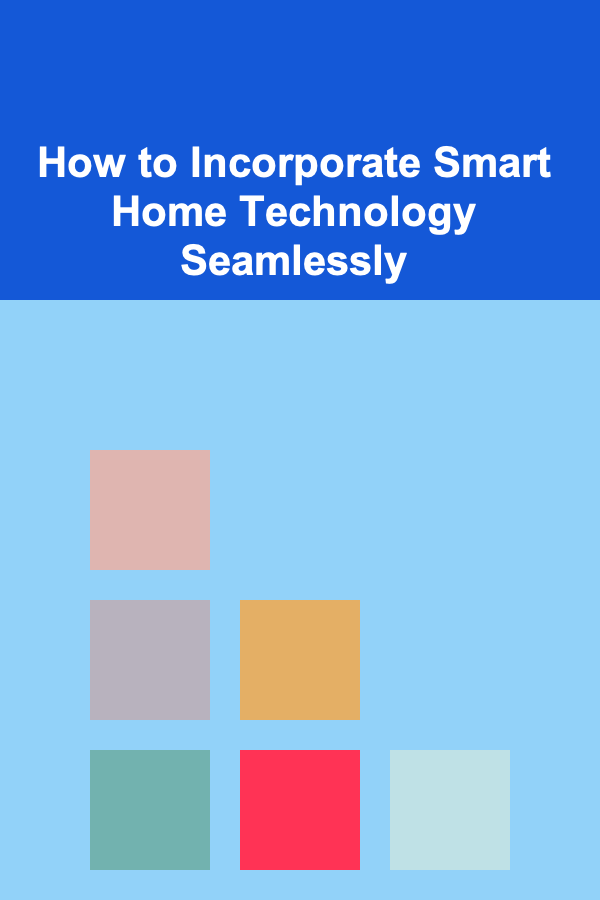
How to Incorporate Smart Home Technology Seamlessly
ebook include PDF & Audio bundle (Micro Guide)
$12.99$11.99
Limited Time Offer! Order within the next:

The smart home revolution is in full swing, and more homeowners than ever are opting to integrate smart technology into their living spaces. The appeal of a smart home lies in its ability to offer convenience, security, energy efficiency, and entertainment with minimal effort. Whether it's controlling the lights from your smartphone, adjusting the thermostat remotely, or ensuring the safety of your home when you're away, smart home devices can enhance your daily life. However, for many, the challenge lies not just in adopting these technologies, but in doing so seamlessly---without overwhelming your space or lifestyle.
This article explores how you can incorporate smart home technology into your home in a way that's efficient, practical, and most importantly, seamless. We'll examine the steps to create a truly integrated home, discuss the essential technologies to consider, and offer practical tips for ensuring that your smart home functions harmoniously with your existing lifestyle.
Start with a Plan
Before diving into the wide world of smart home devices, it's important to have a clear plan. Starting without direction can lead to over-buying devices that you may not need or that don't complement each other. A smart home should be about adding value to your life, not about collecting gadgets. Begin by considering your needs and priorities.
Assess Your Needs
- Convenience: Are you looking to simplify everyday tasks, like turning off lights remotely or controlling your thermostat?
- Security: Do you want to enhance the safety of your home with cameras, alarms, or smart locks?
- Energy Efficiency: Would you like to optimize your energy use and reduce your utility bills with smart appliances and systems?
- Entertainment: Is enhancing your home entertainment system with smart speakers or a connected TV a priority?
By identifying the aspects that matter most to you, you can avoid purchasing unnecessary gadgets. A well-thought-out plan ensures that your smart home is functional, cohesive, and aligned with your lifestyle.
Set a Budget
Smart home technology comes in a wide range of prices, so it's crucial to set a budget. Decide on how much you're willing to spend upfront and consider long-term costs, such as subscription services for smart devices or monthly fees for cloud storage of security footage. Having a budget in place will help you make thoughtful decisions and prevent overspending.
Select the Right Smart Home Ecosystem
One of the most crucial decisions when incorporating smart home technology is choosing the right ecosystem. The two main players in this space are Amazon Alexa , Google Assistant , and Apple HomeKit. Each of these ecosystems is compatible with a variety of devices, but they differ in terms of functionality, device compatibility, and user experience.
Amazon Alexa
Amazon Alexa is arguably the most popular smart home platform. Alexa's voice assistant powers a wide range of devices, including smart speakers (Echo series), lights, thermostats, cameras, and more. One of Alexa's key strengths is its compatibility with thousands of third-party smart devices, allowing you to create a personalized smart home.
Google Assistant
Google Assistant is another major player in the smart home arena. Google's ecosystem works seamlessly with its range of smart devices, including the Google Nest series (thermostats, cameras, etc.) and Google Home speakers. It also integrates well with a wide variety of third-party devices, and its AI capabilities offer excellent voice recognition and search functionalities.
Apple HomeKit
Apple HomeKit provides tight integration with Apple products like iPhones, iPads, and Apple Watches. While HomeKit doesn't have as extensive a range of third-party device support as Alexa or Google Assistant, it offers a highly secure and privacy-focused ecosystem. If you're already an Apple user, HomeKit offers a streamlined experience with all your devices.
When selecting an ecosystem, consider what other devices you already own. For example, if you have an iPhone and use other Apple products, HomeKit may be the best choice. If you prefer open compatibility and a wide selection of devices, Alexa or Google Assistant might be more suitable.
Focus on Key Areas First
While smart homes can include a wide variety of devices, starting with a few key areas will ensure a smoother and more cost-effective integration. These areas can provide immediate benefits and allow you to gradually expand your system as your needs evolve.
Smart Lighting
Lighting is one of the easiest and most impactful areas to integrate smart technology. Smart lights, such as Philips Hue or LIFX bulbs, offer full control over brightness and color. You can adjust the lighting based on time of day, or even create different scenes that match your mood or activity.
A popular starting point is installing a smart hub or a voice-controlled assistant (like Amazon Echo or Google Home) that can control your lights. This way, you can switch lights on or off, dim them, or change colors using voice commands or apps.
Smart Thermostats
A smart thermostat is an excellent investment for improving energy efficiency and comfort. The Nest Thermostat or Ecobee are popular options that learn your heating and cooling preferences over time, adjust automatically, and allow remote control via your smartphone.
Smart thermostats are especially beneficial in managing your home's temperature while you're away. They can adjust the settings to conserve energy and ensure that your home is at the perfect temperature when you return.
Security and Surveillance
Safety is one of the most compelling reasons for installing smart technology. Smart locks, such as August or Schlage , enable remote access to your home without the need for physical keys. Pairing them with video doorbells like Ring or Nest Hello can provide a visual feed and two-way communication for added security.
In addition, smart cameras and motion sensors can help monitor your home while you're away. Many systems, such as Arlo or Nest Cam, offer cloud storage and allow you to check live footage from your smartphone.
Smart Plugs and Appliances
Smart plugs are affordable and easy-to-use devices that allow you to control traditional appliances remotely. These plugs can be used to turn on or off lamps, fans, or other household devices, reducing energy waste and increasing convenience.
Smart appliances, such as refrigerators, ovens, and washing machines, are also growing in popularity. These devices offer remote monitoring and control, allowing you to track your appliance's performance and adjust settings remotely.
Ensure Integration Across Devices
Once you've decided on the devices you want to incorporate into your smart home, the next step is to ensure that they work well together. Device compatibility is crucial for a seamless experience. When planning your home automation system, consider how each device interacts with the others.
Many smart home platforms (like Alexa, Google Assistant, and Apple HomeKit) offer integration with a wide range of devices. For example, if you have a smart thermostat, you can set it to adjust automatically when your smart lights turn off, or when you leave the house.
Consider using if-this-then-that (IFTTT) automation to connect different services or devices. IFTTT allows you to create triggers that automate specific actions, such as turning off all lights when you leave home or adjusting the thermostat based on weather conditions.
Maintain Simplicity and Control
While it's tempting to incorporate every device you can find, it's important to maintain simplicity in your smart home setup. Too many devices can create complexity and lead to frustration, especially if they don't work together smoothly.
Choose a Centralized Control Hub
A centralized control hub is crucial for managing all your devices. This could be a voice assistant like Amazon Echo or Google Nest Hub, or an app on your smartphone. A good control hub allows you to monitor and control all your smart devices in one place, without having to switch between multiple apps or interfaces.
Streamline Your User Interface
While many smart home devices come with their own apps, you don't need to clutter your phone with too many interfaces. Many ecosystems, such as Alexa, Google Assistant, and Apple HomeKit, allow you to control all devices from a single app. This simplifies the experience and ensures that you don't get overwhelmed by managing each device separately.
Prioritize Security and Privacy
As with any connected technology, it's essential to prioritize security and privacy when integrating smart home devices. Many smart devices, such as cameras and doorbells, are constantly connected to the internet and may collect personal data.
Here are some tips for securing your smart home:
- Use Strong Passwords: Ensure that your accounts and devices are protected by strong, unique passwords. Enable two-factor authentication where possible.
- Update Firmware Regularly: Manufacturers often release updates to patch security vulnerabilities. Make sure your devices are up-to-date with the latest firmware.
- Secure Your Wi-Fi Network: Set up a strong, encrypted Wi-Fi network for your smart devices. Consider using a separate network for your smart home devices to reduce the risk of hacking.
Keep the Long-Term in Mind
A smart home is not a one-time setup but an evolving project. As technology advances, new devices and innovations will become available. Stay informed about emerging trends, and consider future-proofing your smart home by choosing devices that are easily upgradeable or adaptable to new standards.
For example, opt for devices that support voice control, as this feature is likely to become even more ubiquitous in the future. Additionally, consider investing in devices that are compatible with newer standards like Matter, an open-source smart home standard that aims to improve device compatibility and security.
Conclusion
Incorporating smart home technology into your life can be a game-changer, offering convenience, security, energy savings, and entertainment. By following these guidelines and taking a measured, thoughtful approach, you can create a seamless smart home that complements your lifestyle rather than complicates it.
By starting with a clear plan, selecting the right ecosystem, focusing on key areas, ensuring device integration, maintaining simplicity, and prioritizing security, you can seamlessly integrate smart technology into your home and enjoy the many benefits it offers.

How to Market Your Automotive and DIY Products with Influencers: An Actionable Guide
Read More
How to Optimize Your Sales Process for Maximum Efficiency
Read More
How to Profit from Affiliate Marketing
Read More
How to Secure Your Home When You Live in a Rental
Read More
How to Stage Your Home for an Open House Event
Read More
How to Use Your Pet to Make Money
Read MoreOther Products

How to Market Your Automotive and DIY Products with Influencers: An Actionable Guide
Read More
How to Optimize Your Sales Process for Maximum Efficiency
Read More
How to Profit from Affiliate Marketing
Read More
How to Secure Your Home When You Live in a Rental
Read More
How to Stage Your Home for an Open House Event
Read More